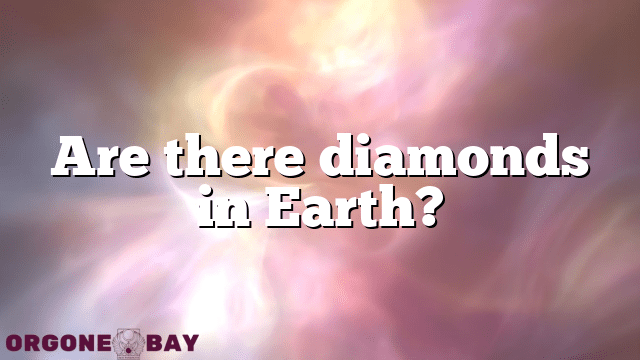Crystal Basics & Properties
Are there diamonds in Earth?
Yes, there are diamonds in Earth! In fact, the vast majority of diamonds are found around 150-200 kilometers below the surface. However, there are a few diamonds that come from far deeper within the Earth’s mantle. Here are some interesting facts about diamonds:
- Diamonds are formed under intense heat and pressure, often from carbon-rich materials found in the Earth’s mantle.
- Diamonds are the hardest natural substance on Earth, meaning they have a high resistance to scratching and are often used for industrial purposes as well as being prized gemstones.
- While most diamonds are mined from underground, some can be found in riverbeds and other deposits on the Earth’s surface.
- In addition to being beautiful and valuable, diamonds have been associated with spiritual and healing properties for centuries.
- Many believe that diamonds have the power to enhance spiritual and psychic abilities, amplify energy, and promote clarity and focus.
So whether you’re interested in diamonds for their beauty and value, or for their spiritual and metaphysical properties, it’s clear that these precious stones have a lot of power and meaning behind them.
Table Of Contents
- 1 The Formation of Diamonds in Earth’s Mantle
- 2 The Journey of Diamonds to Earth’s Surface
- 3 Exploration and Mining Techniques for Diamonds
- 4 Unique Properties of Diamonds and their Industrial Applications
- 5 Diamonds as a Symbol of Luxury and Rarity
- 6 Ethics and Sustainability in Diamond Mining Practices
The Formation of Diamonds in Earth’s Mantle
Diamonds are formed deep within the Earth’s mantle, about 150-200 kilometers below the surface. This is due to the extreme pressures and temperatures present in this region. Carbon-rich materials, such as organic material, are subjected to immense pressure and heat, which causes them to transform into diamonds. These carbon-rich materials are found in the magma that rises from the mantle, eventually reaching the surface as volcanic eruptions.
The process of diamond formation in the Earth’s mantle can take millions to billions of years. However, scientists believe that diamonds can also form from meteorites that collided with Earth in the distant past. These meteorites may have had the necessary conditions for diamond formation, which led to the formation of diamonds on Earth’s surface.
The Journey of Diamonds to Earth’s Surface
After diamonds are formed deep within the Earth’s mantle, they can be brought to the surface through volcanic eruptions. These eruptions release the magma and rocks that contain the diamonds onto the Earth’s surface. Once the diamonds are exposed, they can be collected from the ground by diamond miners and companies.
It is important to note that not all volcanic eruptions contain diamonds, and even if they do, the diamonds may not be of high enough quality to be worth mining. Diamond miners must carefully search for indications of diamond-bearing rocks before beginning the mining process.
Exploration and Mining Techniques for Diamonds
Exploration for diamond mines involves the use of several techniques such as drilling, aerial photography, and geophysical surveys. These methods help geologists and miners identify potential diamond mines by analyzing the geology of the area and searching for indicators, such as kimberlite pipes, that may contain diamonds.
Once the diamonds are found, mining for them involves various techniques, such as open pit mining and underground mining. Open pit mining involves creating a large, open hole in the ground to access the diamond-bearing rock layers. Underground mining involves tunneling into the ground to access the diamond-bearing rocks. Both methods involve the use of heavy machinery and equipment to extract and process the diamonds.
Unique Properties of Diamonds and their Industrial Applications
Diamonds are one of the hardest and most durable materials on Earth, making them valuable for industrial applications. Their unique properties, such as their hardness, high thermal conductivity, and low electrical conductivity, make them suitable for use in industries such as cutting, drilling, and polishing.
Diamonds are also used in the electronics industry for their ability to transmit heat away from sensitive electronic components, ensuring that they function efficiently without overheating. Additionally, diamonds are used in the medical industry for certain surgical procedures, as they are biocompatible and resist damage.
Diamonds as a Symbol of Luxury and Rarity
Diamonds have long been associated with luxury and rarity, making them a symbol of wealth and social status. They are often used in jewelry, particularly engagement rings, due to their beauty and durability. Diamonds are also used in luxury watches and other accessories.
The rarity of diamonds also contributes to their value, as they are not found in large quantities and require significant resources to mine and process. This has led to a high demand for diamonds, particularly those of high quality and large size.
Ethics and Sustainability in Diamond Mining Practices
The mining and production of diamonds have come under scrutiny in recent years due to concerns about ethical and sustainable practices. Diamond mining can have significant environmental impacts, such as deforestation, soil erosion, and water pollution. Additionally, the working conditions for diamond miners can be dangerous and exploitative.
To address these concerns, various initiatives have been implemented to promote ethical and sustainable diamond mining practices. This includes certification programs, such as the Kimberley Process Certification Scheme, which ensures that diamonds are not obtained through illegal means, such as conflict or exploitation. In addition, efforts are being made to promote fair labor practices and reduce the environmental impact of diamond mining.

